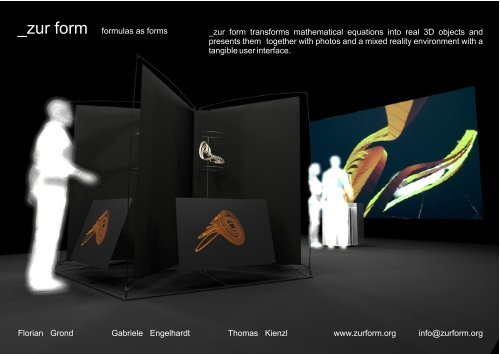Florian Grond Gabriele Engelhardt Thomas Kienzl www.zurform.org ...
Florian Grond Gabriele Engelhardt Thomas Kienzl www.zurform.org ...
Florian Grond Gabriele Engelhardt Thomas Kienzl www.zurform.org ...
You also want an ePaper? Increase the reach of your titles
YUMPU automatically turns print PDFs into web optimized ePapers that Google loves.
_zur form formulas as forms<br />
_zur form transforms mathematical equations into real 3D objects and<br />
presents them together with photos and a mixed reality environment with a<br />
tangible user interface.<br />
<strong>Florian</strong> <strong>Grond</strong> <strong>Gabriele</strong> <strong>Engelhardt</strong> <strong>Thomas</strong> <strong>Kienzl</strong> <strong>www</strong>.<strong>zurform</strong>.<strong>org</strong> info@<strong>zurform</strong>.<strong>org</strong>
_zur form (_on form) is a collaborative mixed-reality installation by <strong>Florian</strong> <strong>Grond</strong>, <strong>Thomas</strong> <strong>Kienzl</strong> and <strong>Gabriele</strong> <strong>Engelhardt</strong>. In it, mathematical formulas are<br />
transformed into 3D forms and are presented as sculptures together with a tangible mixed reality installation. The project also features photographs of the support<br />
forms, the negative casts that emerge out of the form production process.<br />
_zur form makes a contemporary contribution to the well-established tradition of representing mathematical functions as 3D forms, which dates back to 19th-century<br />
Germany. The early forms inspired a number of artists in the 19th and 20th centuries, and also became the point of departure for the conception of our project.<br />
In German, the word “begreifen” (to understand) literally means to grasp an idea, as with a hand. The transformation of formulas into forms also emphasizes the<br />
original meaning of the word “information,” which is “bringing into form.” Thus, by making tangible objects out of abstract mathematical concepts, the sculptures and<br />
their representations underline both the material and physiological aspects that pertain to the construction and accessibility of knowledge.<br />
The represented forms emerged out of <strong>Florian</strong> <strong>Grond</strong>’s research into the stability of chaotic attractors, which are solutions to nonlinear differential equations. <strong>Grond</strong><br />
developed algorithms that accentuate the curious topological properties of chaotic attractors.<br />
<strong>Thomas</strong> <strong>Kienzl</strong> developed a tangible mixed reality interface (MRI) for the project. The MRI allows for a tactile manipulation of the mathematical objects in virtual<br />
space.<br />
<strong>Gabriele</strong> <strong>Engelhardt</strong>’s photographic work focuses on various sculptural elements. With her photographs of the negative casts of these forms, <strong>Engelhardt</strong> extends the<br />
tradition of using mathematical functions as model objects in the history of photography.<br />
The production of models of mathematical functions and their relation to Modern Art has a fascinating history. It dates back to the 19th century, when concrete plaster<br />
models of mathematical formulas were used to facilitate the understanding of complex geometrical problems. A number of 19th-century mathematicians employed<br />
these models, among them Felix Klein. Plaster mathematical forms were distributed worldwide, and they can still be found in many mathematical institutes.<br />
In the beginning of the 20th century, the market for mathematical models was saturated and the model building business declined. At the time, however, artists<br />
became increasingly interested in these curious forms and used them as models for photographs or as a source of inspiration for sculptures and paintings. Amongst<br />
these artists were Naum Gabo, Antoine Pevsner, Barbara Hepworth, and Henry Moore. Later, Ruth Vollmer and Gego (Gertrude Goldschmidt) also used<br />
mathematical forms as sources for their artistic work. These mathematical forms continue to inspire contemporary artistic productions, such as Hiroshi Sugimoto’s<br />
“Conceptual Forms” photographic series.<br />
The formulas taken as the starting points for our project are nonlinear differential equations. Some of them exhibit particularly curious solutions, which have come to<br />
be known as “chaotic” or “strange” attractors. Al-though these solutions are fully determined by the underlying equations, they nonetheless contain unpredictable,<br />
non-periodic behaviors.<br />
The best known chaotic attractor was found by accident in 1963, when meteorologist Edward Lorenz numerically approximated the solution for a nonlinear equation<br />
which described weather phenomena (the Lorenz attractor). Many people know of the Lorenz attractor (often together with the notion of the butterfly effect) as being<br />
the first of its kind. But it was in fact the Japanese scientist Yoshisuke Ueda who first encountered non-periodic behavior (also accidentally) during his analog<br />
computer experiments in 1961. The attractor he found looked like a shattered egg, and was later named “Japanese attractor” by the French mathematician Davide<br />
Ruelle. In the 1970s, Otto Rössler purposely designed nonlinear equations with chaotic behaviors. His first and widely investigated result is named after him: the<br />
Rössler attractor. Later, many different equations were found all over the world. In the 1990s, for instance, J. C. Sprott developed a program which systematically<br />
searches a parameter space in order to find all the possible simple prototypes of chaotic attractors in 3 dimensions.<br />
Since research into nonlinear systems with chaotic solutions often relies on numerical approximations, the visualization of results is of particular importance. In effect,<br />
the image is essential in effectively communicating the results. Our project, _zur form, aims to bring these virtual images back to 3D reality, and situates them to this<br />
end in the established tradition of 3D mathematical objects.<br />
For the installation, we have chosen to produce the Lorenz and the Rössler attractors, as well as three examples from Sprott’s prototypes, all in 3D forms. Chaotic<br />
attractors are usually depicted as a single trajectory in one long thin line. In our models, we represent this line as a ribbon which indicates the principle directions of<br />
stability. These ribbons either make simple loops or wind like Möbius strips and allow for a visual interpretation of their curious topological structures.<br />
<strong>Florian</strong> <strong>Grond</strong> <strong>Gabriele</strong> <strong>Engelhardt</strong> <strong>Thomas</strong> <strong>Kienzl</strong> <strong>www</strong>.<strong>zurform</strong>.<strong>org</strong> info@<strong>zurform</strong>.<strong>org</strong>



